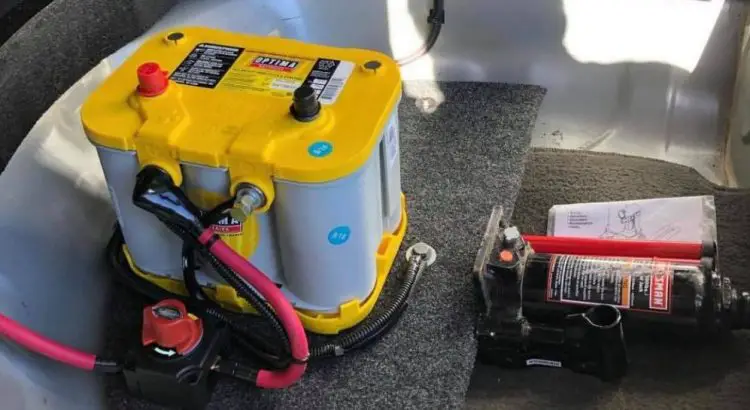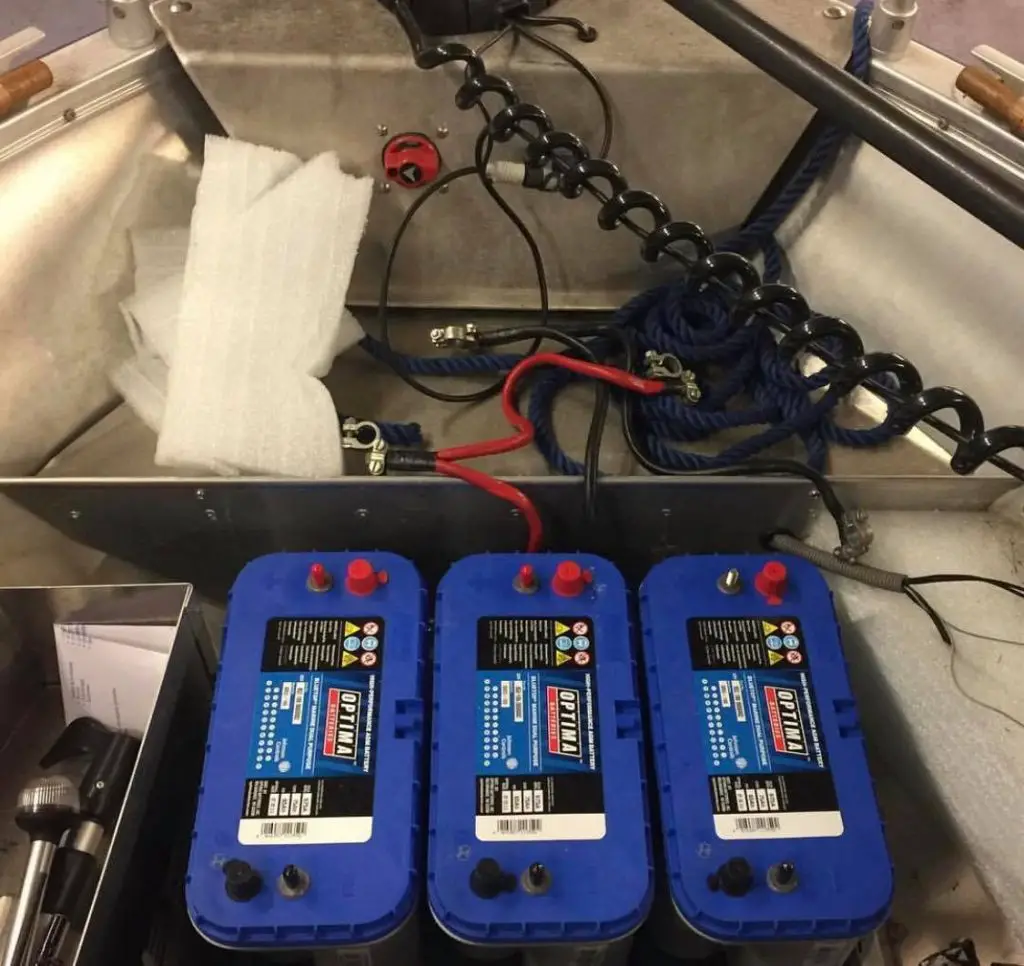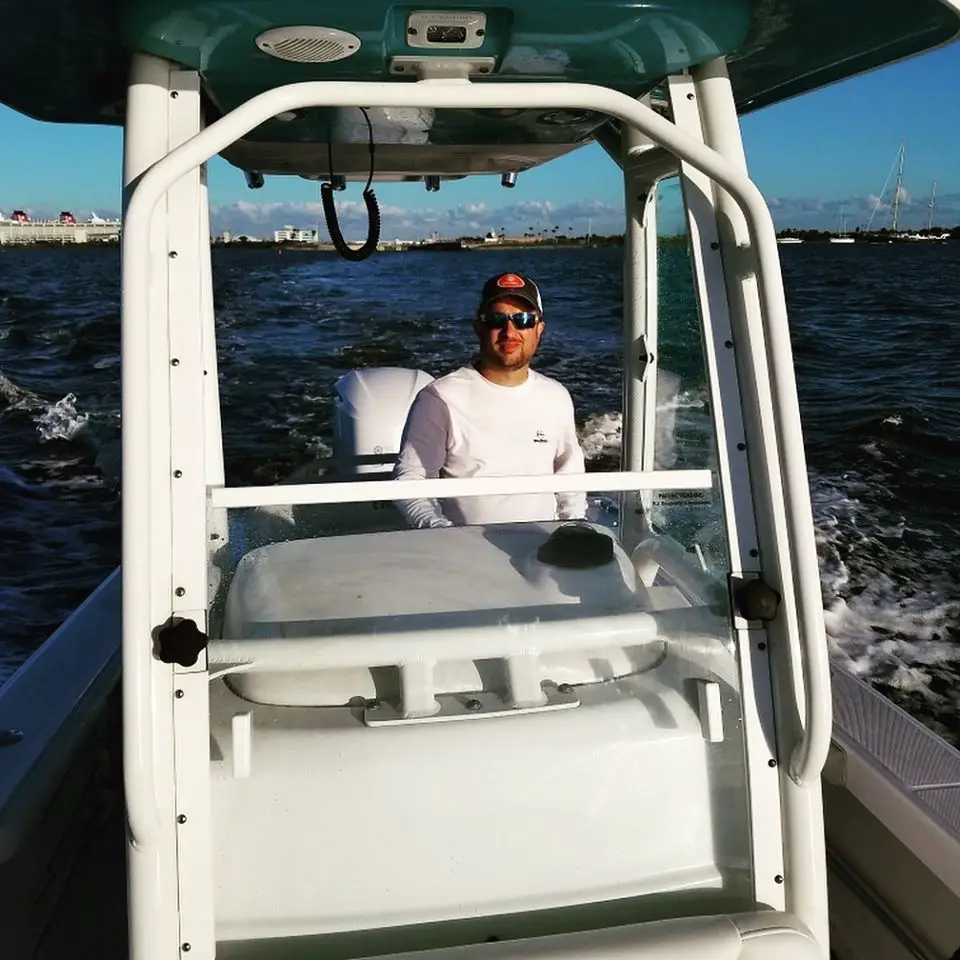This page contains affiliate links. This means that we may get a small commission for recommending products, if you choose to click on something and buy it. This does not cost you anything, but we wanted to be honest and let you know!
(Last Updated On: )In order to start the motor or power up electrical equipment on board your boat, you will need a reliable marine battery.
You have two types to choose to depend upon its usage, which includes a starting and deep cycle ones.
The best marine battery is the Optima Batteries 8016-103 D34M BlueTop with a powerful 12 volt, 750 CCA specification that is perfect for bad weather.
Unlike car batteries, the marine alternative will store a higher voltage and discharge huge amounts of electrical current for an extended period of time.
They are used for cranking and powering boats throughout the entire duration of use.
Table of Contents
Best Marine Battery
| Marine Battery | Preview | CCA |
| Optima 8016-103 D34M | 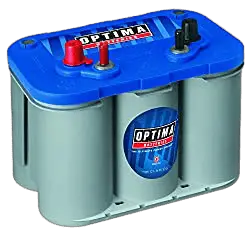 | 750 |
| Odyssey 31M-PC2150ST-M | 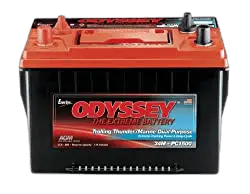 | 1,150 |
| VMAXTANKS VMax857 | 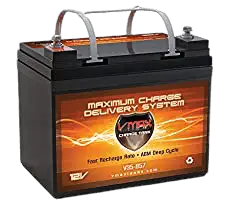 | 300 |
| Weize 12V 100AH | 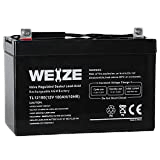 | N/A |
| Mighty Max Battery | 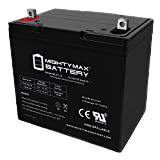 | N/A |
Deciding on the battery you need for your boat is dependent upon whether you need it to start the engine or power up devices and appliances onboard.
For a marine starter battery, cold cranking amps (CCA) is a rating to check out whereas, for deep cycle marine batteries, power is the most important factor.
AGM marine batteries are the preferred type of battery because they are able to contain the battery acid and ensure that it does not leak whatsoever.
Factors such as types, weight, dimensions, capacity, cold cranking amps and much more go into finding the best battery for your boat.
Below is a list of the best marine batteries that provide a reliable source of power.
Optima Batteries BlueTop Marine Battery
Optima produces a wide variety of boat batteries that are popular among enthusiasts.
The BlueTop is a dual purpose marine battery with both starting and deep cycling qualities without the need for multiple batteries.
In terms of the specification of this Optima 8016-103, it includes:
- 750 Cold Cranking Amps
- 12 Volts with a 55 Ah C20 Capacity
- 10 x 6 7/8 x 7 13/16 inches
- Weighs 43.5 LBS
- The reserve battery capacity of 120 minutes
It is an AGM marine battery that is high performing in any weather and is able to withstand heavy vibration.
Although it is a dual-purpose battery, it is best used as a deep cycling battery but the ability to work for both is a huge bonus.
Overall, it is the best dual-purpose marine battery for your boat with excellent starting power and deep cycling abilities.
For those looking for a single battery, there is no alternative that comes close to the performance and value for money.
Odyssey 31M-PC2150ST-M Marine Starting Battery
The Odyssey 31M-PC2150ST is a premium battery that is a top-rated cranking marine battery.
With a huge 1,150 CCA, it is by far the highest Cold Crank Amps battery within this article and it is warranted at 3 and 4-year full replacement.
In terms of the specification of the Odyssey 31M-PC2150ST, it includes:
- 1,150 Cold Cranking Amps
- 100 Ah Capacity
- Operates in -40 to 80 degree Celsius temperatures
- Full recharging in 4 to 6 hours
- 13 x 6.8 x 9.41 in size and a weight of 77.8 LBS
The estimated lifespan of the Odyssey boat battery is between 3 and 10 years of service with a longer cycle life than the majority of deep cycle batteries.
You can achieve up to 400 cycles at 80% depth of discharge.
It is one of the biggest marine batteries and requires a large amount of lead to performs as it does.
It is an AGM battery that will not spill and includes brass terminals that are highly conductive and do not corrode over time.
Overall, it is the best marine starting battery for boats with the biggest CCA rating in this article.
It is also a fairly heavy-duty to the point it will withstand extreme loads, vibrations, long idling, and other aggressive uses.
VMAXTANKS Vmax857 Marine Deep Cycle Battery
The VMax857 is an AGM design deep cycle marine battery with a reasonable price tag.
It can be used for a range of boats include powerful trolling motors that require a certain amount of power to be able to use all the available thrust.
In terms of the specification of the VMax857, it includes:
- 35 Ah capacity
- 300 Cold Cranking Amps
- The lifespan of 5 to 8 years when in float mode
- Weighs just 25 LBS for easy transportation
- Length of 7.7 by the width of 5 and a height of 6.1 inches
The build quality of this battery is fairly impressive with particular focus on the physical and chemical structure of the plates.
During the manufacturing process, they undergo treatment to enhance the strength and reliability of the marine battery.
Overall, the VMaxtanks VMax857 is the best deep cycle marine battery that provides excellent value for money along with impressive build quality.
It is also the best trolling motor battery for those that use thrust to power their boat along the water.
Weize 12V 100AH Deep Cycle
Weize Series 12V 100AMP is a Deep Cycle Battery that is heavy-duty and calcium allow grid that gives unique performance and service life in both float and cyclic applications.
The design of this marine battery is equipped with Absorbent Glass Mat technology that allows you to use this battery in enclosed and indoor environments without leaking or extra maintenance.
You can use this battery in a variety of ways like Solar panels, portable tools, emergency lighting, back-up sump pump, electric vehicles, travel trailer, and more.
It is also dependable because of its high performance and deep cycle which means it has a long service life and deep discharge recovery.
The specifications of the Weize Series 12V 100AMP include:
- 12V 100 Amp Hour Sealed Lead Acid Rechargeable
- 100 Ah capacity
- 12.09 inches x 6.65 inches x 9.17 inches and weighs 57LBS
ML55-12
If you are looking for an affordable marine battery that provides a reliable source of power, then the Might Max Boat Battery may be your best buy.
It is an AGM construction that has the benefit of high discharge rates, wide operating temperatures, and long service life.
The MightMax boat battery has the following specification:
- 12V 55 Ah Capacity
- 9 x 5.43 x 9.13 inches and a weight of 38.5 LBS
- 1-year warranty
- The expected lifespan of 2 years
The ML55-12 is the better buy compared to the weaker ML35 version and it is ideal for trolling motors with a maximum of 30 LBS of thrust.
Compared with the VMax857, it is very close but the MightMax has a much greater Ah rating but this does result in a heavier marine battery.
Both are top-rated trolling motor batteries that provide a reliable source of power.
Marine Battery Buying Guide
The marine battery has improved hugely thanks to the advancements in battery technology.
When investing a large amount of money into one, there are many factors to consider so that you are able to get the reliability and performance you require.
Factors such as capacity, CCA, maintenance, design are just a few of the many considerations.
You will also need to decide on whether you require a starting, deep cycle or dual-purpose battery for your boat too.
Each has its own benefits and drawbacks but you must purchase the correct type for its intended purpose.
To help you make a more informed buying decision, we have produced an in-depth buying guide as shown below.
What Types of Marine Batteries Are there?
When it comes to the marine battery, there are three main types of battery that you can install to your boat.
Not everyone will require a constant source of 12V in order to power onboard appliances, therefore a starting battery is more suited to their needs.
Below is a brief description of each marine battery type.
Deep Cycle Batteries
The boats that have electrical appliances onboard or use a trolling motor will require a consistent power source instead of all the power at once.
This is where a deep cycle marine battery is required as they provide the appliances or trolling motor with a steady flow of electricity.
Attempting to use another type of battery could send too much voltage to the appliances and potentially cause damage, so it’s important that you test beforehand.
Starting Batteries
In order to start an outboard or inboard motor, you will require a starting marine battery that delivers a large number of cold cranking amps (CCA).
This will then power up the ignition and begin the combustion process.
They provide a sudden burst of power and once they have performed their intended task, they remain idle until they are needed.
Dual Purpose Batteries
The best way to describe a dual purpose marine battery is a combination of the two types above.
It provides a large number of cold cranking amps whilst also having enough reserve capacity to power appliances or trolling motors.
These types of batteries often cost more but the convenience of having a single battery to perform both starting and deep cycles is worth the price tag.
However, you will always have better performance if you were to use a single purpose battery.
Battery Groups and Slots
Marine batteries come in various sizes designated as 27, 24, 6D, 31, 8D, and so on.
The size of the battery box or slot will help you figure out the correct size of the battery that is required.
The number of battery slots that are provided by the boat manufacturer may vary.
If there are numerous slots available, it’s worthwhile having different types of batteries to benefits from the various advantages that each type offers.
Cold Cranking Amps
The abbreviation CCA stands for Cold Cranking Amps and it is a measurement of a battery starting power within a short duration of time.
The rating provided displays how much of the electrical power is generated within 30 seconds at zero degrees Fahrenheit.
For starting most small to medium outboard motors, a rating of 600 CCA should be enough to start the motor.
However, a larger CCA rating will be more capable of starting the motor and it is always recommended to choose a battery that exceeds the minimum requirements.
Reserve Capacity Rating
Reserve capacity is a rating that you will want to check when purchasing a deep cycle marine battery.
It is a measure of the length of time a fully charged battery delivers 25 amps of current before being discharged below 10.5 volts at 80 degrees Fahrenheit.
For instance, a battery with a reserve capacity rating of 150 minutes can last for two and a half hours while discharging a load of 25 Amperes.
When searching for the best deep cycle marine battery, you will want to look out for high reserve capacities.
This will allow for high electrical demands to power all the electrical equipment on board of your boat.
Manufacturing Date
Batteries are primarily powered by stored chemicals that will diminish over the years.
Therefore the date of manufacture has a significant bearing on whether it is suitable for use or not. You will be able to find the date labeled on the battery itself.
If you have just replaced the battery or are looking to purchase a one-second hand, this is something you will want to check.
If the battery is a lot older than it should be, you will want to attempt to get your money back as it will not perform as well as a battery that is closer to the current date.
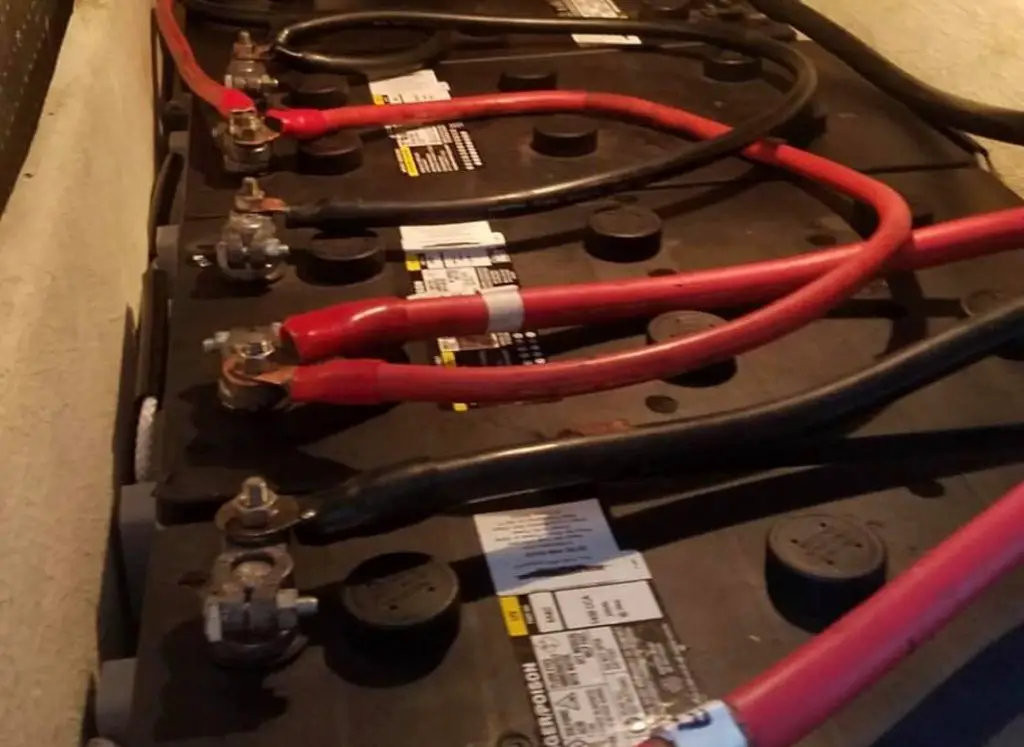
What to Look for in Durability and Design?
Unlike other batteries found in your car, golf cart or other location, they are not subjected to the tough marine environment.
Therefore a marine battery is designed to withstand poor conditions and can be mounted in numerous positions.
Along with the poor conditions is the trouble of excess vibrations and movements from the waves, which can also cause damage.
However, to combat this, marine batteries feature thicker plates and durable seals that help prevent the deterioration of the battery.
Marine Battery Maintenance
Thanks to modern marine battery technology, you no longer need to deal with the regular maintenance of the older lead-acid batteries.
This means no wiping spillages or refilling electrolytes, which is very beneficial to the average boat owner.
AGM batteries are the preferred type of marine battery as they are leak-proof, mountable in any position and require virtually zero maintenance.
Marine Battery Maintenance Quick Tips
Clean The Terminals: Make sure to periodically clean terminals and the battery case. You can do this in one of two ways.
You can buy an inexpensive tool that gets into the threads of the terminals to clean out corrosion.
Make a paste of baking soda and water, as that will help to neutralize any acid. Use a toothbrush to clean between the threads on the terminal.
Grease and acid can create a film across the surface of a battery case. That film can be conductible between the two terminals and cause the battery to discharge.
Wet Cell Batteries: If you still have a wet cell or conventional battery, check the cells to see if they are low. If they need filling, use ONLY distilled water and put on protective eyewear.
The distilled water can splash when you are filling the cells, and you don’t want the acid from the battery to get in your eyes.
Remove the covers that are over the cells by prying them off with a screwdriver. Clean these covers before replacing them.
Check to see if the battery has plates exposed or close to exposure. Also, check to see if the levels are equal in each cell.
In general, you should add enough water to cover the electrodes or plates.
Cover The Terminal: Make sure that the positive terminals on your battery are covered.
A rubberized “boot” can be purchased cheaply that covers the terminals.
This inexpensive item can prevent sparks, arcing, and a possible explosion if something like a tool is dropped on the terminal.
On a boat that might be tossed on the waves, this is a no-brainer to have. Even if you have your battery in a covered box, use a cover for the terminals.
Grease The Terminals: Coat the battery terminals with a light coat of dielectric grease. You want to use this type of grease as it is a non-conductive grease.
Don’t put too much on as it will increase resistance.
Make A Note Of The Date: Mark your battery with the date that it was installed. Your battery might have a factory label, but those labels don’t last in the bilge.
Secure It: It is best to have your battery in a box or on a bracket with threaded rod and nuts secured to plastic webbing straps.
Whatever you secure it with should be able to withstand 75 pounds of force. If you are in rough water and your battery goes skittering across the deck and over the side, you are also going to be in rough shape trying to get back to shore.
Do A Swap Out: If your battery terminal has wing nuts, swap them out for the lock nuts.
Wingnuts will come loose with vibration where the nuts will not. A loose connection can impair charging and hinder output.
Get A Full Charge: Invest in a meter reader. You can purchase one for about $20. A digital multimeter will give you an accurate check on the status of your battery.
Once you have a meter, place the probes on the battery terminal, and it will provide you with a reading. Charge your battery fully.
- 12.65 to 12.77 volts is a full charge
- 12.45 to 12.54 volts is a 75-percent charge
- 12.24 to 12.29 volts is a 50-percent charged
- 11.99 to 12.06 volts is a 25-percent charged
- 11.75 to 11.89 volts the battery is dead
How Do You Charge a Marine Battery?
To ensure that the battery is fully charged, you will require a marine battery charger to keep it topped up.
The electric appliances on boats will draw current from the deep cycle battery over time and it will need to be topped up regularly to prevent lasting damage to the battery.
There are many methods of charging the battery from onboard chargers to portable alternatives.
Onboard chargers are often found on larger boats with multiple batteries that can be charged simultaneously.
Does my boat motor charge my battery?
Most outboard motors that have an electric start will also recharge the battery as it runs, much like a car battery does.
If you let a deep cycle battery become depleted, or if it sits uncharged, it will negatively impact the longevity of the battery.
Do Marine Batteries Need Ventilation?
Yes, you do need to vent marine batteries. Even though the battery is sealed, it will have a venting system that is integrated on the case top.
If a battery is overcharged, excess pressure can build up inside the battery.
Ventilation will also limit the temperature rise that occurs when the battery is being charged.
Can you overcharge a marine battery?
Yes, you can overcharge a battery, and you want to avoid doing this at all costs.
Overcharging will do more damage than if you let your battery discharge.
In overcharging a battery, the acid inside begins to boil. The battery can crack or even explode.
That kind of event would ruin the battery at best and cause a fire on your boat at worst.
How To tell if a deep cycle battery is bad
Before you start to test the battery, make sure you have:
- Manufacturer’s specifications for the battery
- Battery testing hydrometer (measures specific gravity)
- Digital voltmeter
- A digital battery load tester
Look at the battery to see if you can see any type of damage to the battery case or either of the terminals. If you do see the damage, then replace the battery, don’t use it.
Check the level of the electrolyte and determine if the battery plates are covered. Charge the battery fully before you test it.
Use a hydrometer and get a reading of all of the cells in the battery. The way to do this is to squeeze the bulb and release it so that it sucks up some of the electrolytes.
Read the specific gravity measurement and refer to the spec sheet. Look for the minimum acceptable reading and the difference of specific gravity between cells.
Next, you will want to take a voltage reading with a voltmeter and compare it to manufacturer spec for a fully charged battery.
Follow the directions for the digital load tester by testing the battery while it is being placed under a load. A digital load tester will indicate if the battery has an interior defect.
If the battery fails any of the tests, unfortunately, it will have to be replaced.
Follow the instructions for the digital load tester, and test the battery while it is being placed under a load.
This type of tester will not necessarily measure the battery capacity, but it will indicate whether or not the battery has an interior defect.
A battery that fails any of the tests with these methods will need to be replaced.
Marine battery winterizing
If you bring your battery off the boat for the winter, charge the battery and then remove the negative cable.
Wait a few hours and then check the specific gravity. Each cell should have a specific gravity of between 1.21 and 1.28 on the hydrometer.
If you use a voltmeter, the fully charged battery will read about 12.5 volts.
Use a trickle charger to maintain the charge every month. If you leave the battery on the boat over the winter, make sure to switch off all of the breakers except the breaker for the bilge pump.
Check the levels of fluid in the battery, and if need be, bring it up to level with distilled water just enough to cover the plates.
Conclusion
All of the recommended marine batteries in this article are suitable for a range of different applications. They are all an AGM construction too, which means they require almost zero maintenance whatsoever.
However, before you purchasing any marine battery, you should ensure that you are choosing the correct type.
If your boat is able to accommodate multiple batteries, we highly recommend having one battery for starting and the other for deep cycling.
Marine Battery FAQ
What are the differences between a starting and deep cycle battery?
A starting marine battery is designed to start the boat motor. It delivers a steady flow of electricity. The deep cycle battery is designed to be discharged down to 20% of its maximum charge repetitively. It is used to power the onboard appliances or trolling motor.
How long will my battery last?
It all depends on the way you will use it and how well you will maintain the battery. Don’t overcharge it and don’t undercharge it.
Starting battery (Automotive battery etc): 3-13 months
Marine Battery: 1-6 years / AGM Deep cycle: 4-7 years / Gel Cell Deep Cycle: 2-5 year / Flooded Lead Acid Deep Cycle Battery (L16-RE etc): 4-8 years
How do high or low temperatures affect my batteries?
Your battery’s capacity will increase in hotter temperatures but its life will decrease. In the lower temperatures, the battery will have less capacity but it will tend to last longer.
At freezing point battery capacity is about 20% lower. At 122 degrees F, the battery capacity is around 12% higher.
How can I determine how much battery juice my onboard device needs?
Most electronics come with spec sheets, either in the front or the back of your manual, you’ll see a specs page with all the details.
